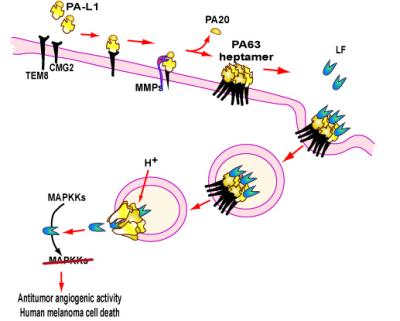Most people wouldn’t consider anthrax toxin to be beneficial, but this bacterial poison may someday be an effective cancer therapy. Anthrax toxin has actually been shown to be fairly selective in targeting melanoma cells, although the risk of non-cancer toxicity prevents any clinical use.
To develop a better and safer treatment, Stephen Leppla and colleagues created a mutated antrax toxin that could only be turned on by matrix metalloproteinases (MMP), proteins that are overproduced only in cancer cells.
When they tested this mutated toxin in mice, the researchers observed that 100% of the animals tolerated a dose that would be lethal for the natural toxin. The MMP-toxin was also better at killing melanoma tumors than natural toxin, due to its higher specificity and longer half-life in the blood.

Even better, Leppla and colleagues saw that MMP-toxin was not limited to melanoma, and could also kill other tumors like colon and lung. This more widespread activity was due to the toxin’s ability to inhibit angiogenesis, or the formation of new blood vessels.
These encouraging mouse results suggest that modified anthrax toxin could be clinically viable, and this potent killer might someday be put to good use.





Comments